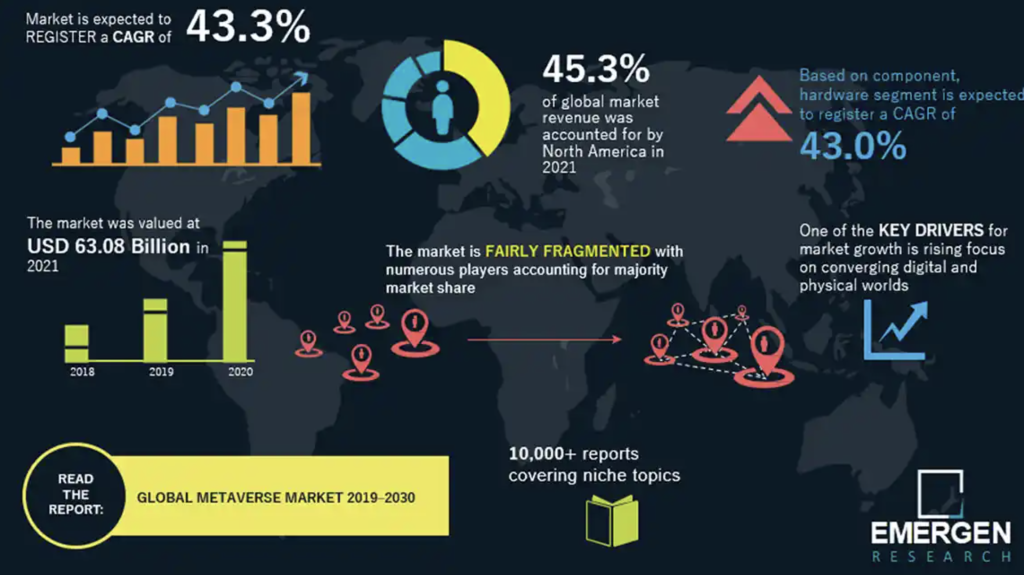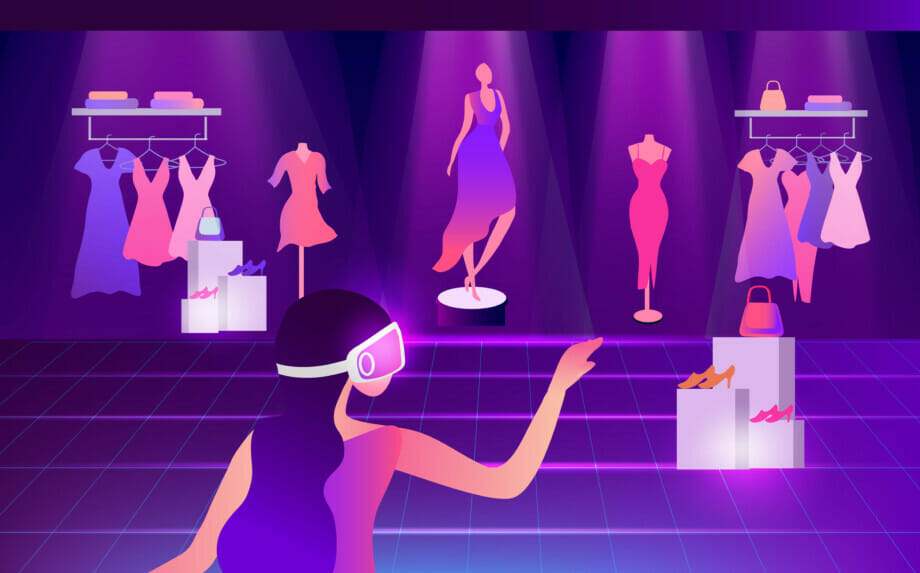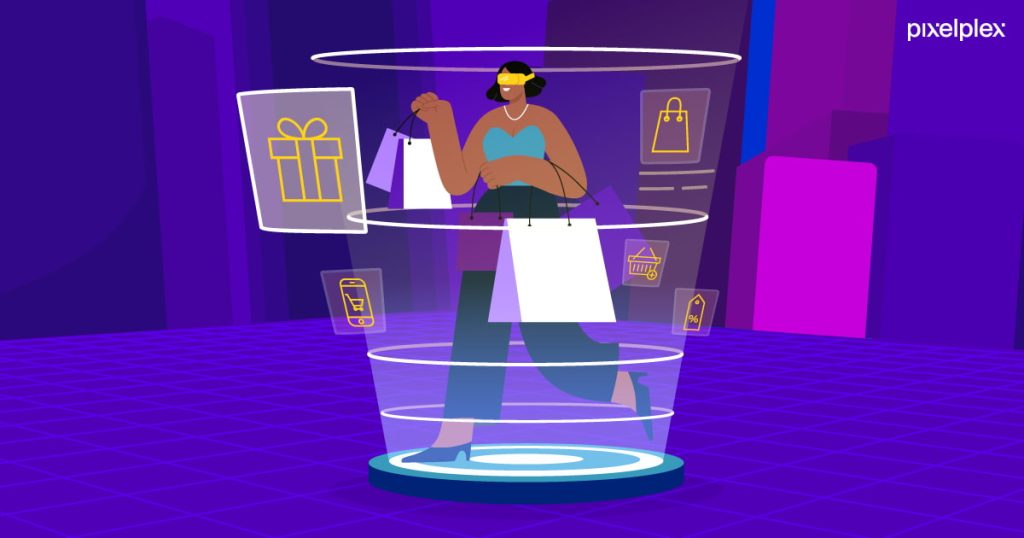Although the Metaverse feels unmistakably new, it seems difficult to imagine a time when words like ‘crypto’ and ‘NFTs’ didn’t dominate global news and trend cycles. But the Metaverse only began creeping into the mainstream in 2020. In this short time in the spotlight, its already become the driver of the biggest cultural trends and a financial force shaking up industries. The only other technology its impact can really be compared with is the Internet. Which as we already know, transformed culture and commerce forever.
A Graph That Only Goes Up
A comprehensive report on the Metaverse and its growth showed that in 2020, the newfound industry was already worth $21.9 billion.

By just 2021 the market had nearly doubled with even the lowest estimate putting the market value at $63 billion.
According to the same report, the Metaverse market is expected to grow at a whopping CAGR of 43.3% till 2030.
The estimates for 2030 begin from $800 billion, and that’s on the low side. JP Morgan estimated the 2030 market value as an unbelievable $1 trillion, with fellow financial giant Morgan Stanley predicting $12 trillion.
The Metaverse was one of the rare industries that shot up even during the pandemic. Rather, it became the naturally positioned solution to the problem the pandemic highlighted — we need better virtual spaces. The pandemic wasn’t just an isolated event, it was a wake-up call to every industry, government, and individual. To withstand and weather chaos, we need to invest in powerful virtual spaces.
Early adopters who realised this included ed-tech, fashion, and gaming. To make the market what it is today, there were many players:
- Tech giants: Meta, Google, Microsoft, Sony etc.
- Fashion brands: Gucci, Vogue, Balenciaga etc.
- Gaming companies: Roblox, Epic Games, Fortnite
- Web3.0 natives: Sandbox, Decentraland
However most importantly, there was investment: venture capital funds worldwide saw the potential of Web3.0 startups with the USA, Dubai, UK, and Singapore becoming hubs for the future of the internet.
The World’s New Marketplace
As the money and users pouring in shows — the Metaverse is rapidly becoming the world’s bonafide marketplace. Just as Web2.0 changed shopping through e-retail, the Metaverse will revolutionise the retail economy.

NFTs and cryptocurrency integration means that users can make instant, independent transactions without ever leaving the world or having to undergo lengthy processes. There are no third parties involved and the transaction is secured using an unhackable peer-to-peer network.
It is a 24/7 functioning open-world platform where users can play games, visit virtual storefronts and attend virtual experiences like fashion shows and concerts. It’s the world’s biggest and most fun store where you can purchase the things your avatar owns and sees and integrate them seamlessly into your real life.

The Metaverse is perfectly poised to usurp the world’s biggest B2C companies by changing the platform to which users flock.
The world is moving on from the internet and onto the Metaverse.
Why Metaverse Marketing Works.
Picture it — you connect your crypto wallet once, chance upon a jacket you like in a Metaverse store, try it on in the AR mirror to see how it looks, and purchase it with a simple gesture.
Now the jacket is for your avatar to flaunt and probably comes with loyalty rewards that translate to real-world discounts and benefits.
You attend a virtual concert where the pass becomes a discount for online merch. Tickets at the fraction of your price from your own home, with all the sound quality and spectacle of a real concert — thanks to your VR headset and sound system.
You have a conversation with someone and get invited to an afterparty where you play through the new Nike virtual experience and pick up some new kicks for your avatar.
You’ve been integrated into a loyalty program that gets you into more parties like this — an exclusive club for the brand’s NFT holders.

The way that the Metaverse entices users and encourages consumer behaviour is almost invisible, while still being spectacular enough to generate buzz:
- Non-invasive: Meta-ads are integrated by existing as normal objects or artistic spaces in the virtual environment. Your ad augments the user’s experience instead of interrupting it
- Precision targeting: AI and machine learning data models mean that businesses can coordinate their strategies better than ever to maximise ROIs.
- Community-focused: Purchases give you access to virtual worlds and experiences while owning certain products becomes a literal badge of belonging. Brands have communities, rather than individual customers.
- NFTs: Anything you can see, you can buy instantly, and display on your avatar and in real life with asset-backed NFTs.
- Convenience: Shoppers will never have to stand in a line again, or guess how an online purchase will look thanks to AR trial rooms. This reduces wasted time, returns, and regrets.
- Hype: By creating 3D artistic experiences that combine music, marketing, film, architecture and narrative, brands can create trending campaigns that can penetrate the mainstream cultural conversation.
More on Metaverse branding.
Creating the Leading Brands of Tomorrow
The first industries and brands to enter the Metaverse for marketing and retail are already reaping their rewards. Gucci found massive success with its virtual world which formed one of its most viral campaigns. Collaborations with leading Metaverse games like Fortnite regularly create trending moments for artists. Reports from multiple industries show that Gen Z’s favourite brands are those that are tapping into these more immersive and creative marketing strategies.
What is an online shopping website or an app in front of a holistic, artistic world that you can immerse yourself in completely from your own house? The Metaverse is built for product integration, brand collaborations, seamless advertising, and forming loyal consumer bases. The brands that capitalise on this the fastest will find themselves growing on the same upward trajectory as the Metaverse is predicted to.

